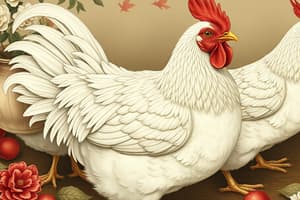Podcast
Questions and Answers
When are IPP required to perform ante-mortem inspection on poultry?
When are IPP required to perform ante-mortem inspection on poultry?
- On the day of slaughter (correct)
- Anytime before the day of slaughter
- Only after the poultry is removed from the truck
- Only after the poultry is placed in coops or batteries
What is one of the signs of disease that IPP may observe on ante-mortem inspection?
What is one of the signs of disease that IPP may observe on ante-mortem inspection?
- Abnormal feather color
- Off-colored feces (correct)
- Abnormal number of healthy birds
- Normal colored feces
What action should IPP take when they observe multiple birds exhibiting signs of disease?
What action should IPP take when they observe multiple birds exhibiting signs of disease?
- Notify the PHV when they observe multiple birds exhibiting signs of disease (correct)
- Condemn the birds on ante-mortem inspection
- Notify the District Office immediately
- Segregate the birds identified as suspects on ante-mortem inspection
What designation is given to birds that on ante-mortem inspection do not clearly show, but the PHV suspects, may have any disease or condition?
What designation is given to birds that on ante-mortem inspection do not clearly show, but the PHV suspects, may have any disease or condition?
What is required of the establishment with regard to birds identified as suspects on ante-mortem inspection?
What is required of the establishment with regard to birds identified as suspects on ante-mortem inspection?
What action should PHVs take when they suspect that birds are affected with a reportable or foreign animal disease?
What action should PHVs take when they suspect that birds are affected with a reportable or foreign animal disease?
What is the action of PHVs when they identify birds with diseases or conditions that warrant condemnation on ante-mortem inspection?
What is the action of PHVs when they identify birds with diseases or conditions that warrant condemnation on ante-mortem inspection?
What is the purpose of ante-mortem inspection by IPP?
What is the purpose of ante-mortem inspection by IPP?
What is the purpose of verifying the disposal of birds condemned on ante-mortem inspection?
What is the purpose of verifying the disposal of birds condemned on ante-mortem inspection?
What should be done with birds that are dead-on-arrivals (DOAs)?
What should be done with birds that are dead-on-arrivals (DOAs)?
What is the consequence of an establishment's ongoing failure to properly handle DOAs?
What is the consequence of an establishment's ongoing failure to properly handle DOAs?
What should be discussed in the weekly meeting with plant management regarding DOAs?
What should be discussed in the weekly meeting with plant management regarding DOAs?
What is the purpose of the ADR function in PHIS?
What is the purpose of the ADR function in PHIS?
What is the reference cited in the SPS NR for systemic failure due to the establishment's lack of process controls to prevent DOAs from entering the slaughter operation?
What is the reference cited in the SPS NR for systemic failure due to the establishment's lack of process controls to prevent DOAs from entering the slaughter operation?
What is the next step if a trend of incidents continues and FSIS determines that the establishment lacks process controls to prevent DOAs from entering the slaughter operation?
What is the next step if a trend of incidents continues and FSIS determines that the establishment lacks process controls to prevent DOAs from entering the slaughter operation?
What is the purpose of online post-mortem inspection procedures for NPIS?
What is the purpose of online post-mortem inspection procedures for NPIS?
Flashcards are hidden until you start studying
Study Notes
Ante-Mortem Inspection
- Ante-mortem inspection is performed by Inspector-in-Place (IPP) on the day of slaughter, observing poultry in coops or batteries before or after removal from the truck.
- IPP observe the overall condition of the birds, including:
- Head, eyes, legs, and body
- Unusual swellings or abnormalities
- Signs of disease that IPP may observe include:
- Abnormal number of moribund birds
- Swelling about the head and eyes
- Edema of the wattles
- Gasping and sneezing
- Off-colored feces
- Diarrhea
- Skin lesions
- Lameness
- Torticollis (wry neck)
- Bone or joint enlargement
- IPP notify the Public Health Veterinarian (PHV) when observing multiple birds exhibiting these signs of disease.
U.S. Suspect Birds
- PHV designates as "U.S.Suspect" any birds that do not clearly show, but PHV suspects, may have a disease or condition that may cause condemnation of part or the entire carcass on post-mortem inspection.
- PHV verifies that the establishment:
- Segregates birds identified as suspects on ante-mortem inspection and slaughters them separately
- Releases poultry for treatment only under the control of the appropriate State or Federal officials
Condemnation and Disposal of Birds
- PHV condemns on ante-mortem inspection any birds with diseases or conditions that warrant such action.
- Establishment must dispose of condemned birds as provided in 9 CFR 381.95.
- Dead-on-arrivals (DOAs) are:
- Identified, counted, and weighed
- Reported on FSIS Form 9061-2, Poultry Condemnation Certificate
- Recorded in the ADR function in PHIS
- DOAs are not allowed to enter the official establishment for slaughter and are removed through live-hang sorting activities.
Post-Mortem Inspection
- Online post-mortem inspection procedures for Non-Poultry Inspection System (NPIS) are described separately in FSIS Directive 6500.1.A.
- Online IPP perform the following procedures during post-mortem inspection:
- Observe the overall condition of the carcass
- Look for evidence of disease or contamination
Studying That Suits You
Use AI to generate personalized quizzes and flashcards to suit your learning preferences.




